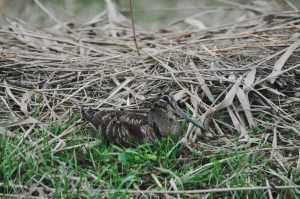
The Eurasian woodcock
We love planting trees – and we do a lot of it! – but another important part of our job at the Heart of England Forest is to look after the existing plantations and mature woodland in our care, so that it remains in the best possible condition for the many different species that live here.
To help us ensure that our woodland management practices provide the right conditions for them to thrive, we’ve been stepping up our survey game. One of the many surveys we’re undertaking this year is for the Eurasian woodcock (Scolopax rusticola), an elusive and characterful wading bird that had previously been spotted on numerous occasions in the Forest.
What is a woodcock?
You’d be quickly forgiven for passing by a woodcock, as they are eminent masters of disguise. Sporting a striped and mottled pattern of varying browns, they blend easily into the leaf litter of herbaceous plants and trees. A woodcock is around the size of a pigeon and has endearingly large eyes to help it see at dawn and dusk. When startled, woodcock fly off in a zig-zag pattern before settling elsewhere, revealing their long, sandpiper-like beak against the sky.
Worryingly, woodcock have been placed on the UK’s “red list” of species of conservation concern, as both their population and range are in decline. This may be down to a number of factors, including habitat fragmentation and lack of habitat management.
The woodcock is dependent on both open grassland and wet woodland for feeding and breeding. Fortunately, the Heart of England Forest contains a good amount of both. Wide, grassy rides between woodland compartments provide a breeding and winter feeding ground, while the dense understorey of the woods offers cover from predators. Woodcock feed primarily on earthworms and beetles, spending much time rootling around in the damp humus of wet woodland.

Roding
One of the most distinctive aspects of woodcock is the male’s mating flight, known as “roding”. Displaying in May and June, males fly around open spaces competing for territory and attracting females. Their croaky call while roding is a very useful means of observation.
During May and June, we are listening out for roding calls at dusk in several areas of the Forest. In our surveys so far we’ve discovered that there are males present but we don’t have conclusive evidence of breeding yet. We’ll keep you posted on any news and we hope woodcock will call the Forest home very soon.

Spotting a woodcock
The latest figures from the British Trust for Ornithology show that woodcock numbers are becoming increasingly concentrated in wooded areas, so it’s more important than ever to provide good habitat. Over the years to come, we’ll continue to plant a diverse range of tree species, maintain rides, control deer numbers and encourage a dense woodland shrub layer so that woodcock can thrive in the Heart of England Forest. You can help, too, by keeping your dogs on leads during the breeding season (April-September) and by reporting any sightings to info@heartofenglandforest.org



